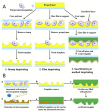Molecularly Imprinted Polymers and Surface Imprinted Polymers Based Electrochemical Biosensor for Infectious Diseases
- PMID: 32069788
- PMCID: PMC7071405
- DOI: 10.3390/s20040996
Molecularly Imprinted Polymers and Surface Imprinted Polymers Based Electrochemical Biosensor for Infectious Diseases
Abstract
Owing to their merits of simple, fast, sensitive, and low cost, electrochemical biosensors have been widely used for the diagnosis of infectious diseases. As a critical element, the receptor determines the selectivity, stability, and accuracy of the electrochemical biosensors. Molecularly imprinted polymers (MIPs) and surface imprinted polymers (SIPs) have great potential to be robust artificial receptors. Therefore, extensive studies have been reported to develop MIPs/SIPs for the detection of infectious diseases with high selectivity and reliability. In this review, we discuss mechanisms of recognition events between imprinted polymers with different biomarkers, such as signaling molecules, microbial toxins, viruses, and bacterial and fungal cells. Then, various preparation methods of MIPs/SIPs for electrochemical biosensors are summarized. Especially, the methods of electropolymerization and micro-contact imprinting are emphasized. Furthermore, applications of MIPs/SIPs based electrochemical biosensors for infectious disease detection are highlighted. At last, challenges and perspectives are discussed.
Keywords: biomarkers for infectious diseases; electrochemical biosensor; molecularly imprinted polymers (MIPs); surface imprinted polymers (SIPs).
Conflict of interest statement
The authors declare no conflict of interest.
Figures






Similar articles
-
Recent advances and future prospects in molecularly imprinted polymers-based electrochemical biosensors.Biosens Bioelectron. 2018 Feb 15;100:56-70. doi: 10.1016/j.bios.2017.08.058. Epub 2017 Aug 30. Biosens Bioelectron. 2018. PMID: 28863325 Review.
-
Internet-of-things-integrated molecularly imprinted polymer-based electrochemical nano-sensors for pesticide detection in the environment and food products.Environ Pollut. 2024 Jun 15;351:124029. doi: 10.1016/j.envpol.2024.124029. Epub 2024 Apr 23. Environ Pollut. 2024. PMID: 38663510 Review.
-
Molecularly imprinted polymers for sample preparation and biosensing in food analysis: Progress and perspectives.Biosens Bioelectron. 2017 May 15;91:606-615. doi: 10.1016/j.bios.2017.01.018. Epub 2017 Jan 11. Biosens Bioelectron. 2017. PMID: 28103516 Review.
-
Photopolymerization and photostructuring of molecularly imprinted polymers for sensor applications--a review.Anal Chim Acta. 2012 Mar 2;717:7-20. doi: 10.1016/j.aca.2011.12.026. Epub 2011 Dec 22. Anal Chim Acta. 2012. PMID: 22304811 Review.
-
Recent advances in molecularly imprinted polymer-based electrochemical sensors.Biosens Bioelectron. 2024 Apr 1;249:116018. doi: 10.1016/j.bios.2024.116018. Epub 2024 Jan 11. Biosens Bioelectron. 2024. PMID: 38232451 Review.
Cited by
-
Signal amplification of a quartz crystal microbalance immunosensor by gold nanoparticles-polyethyleneimine for hepatitis B biomarker detection.Sci Rep. 2023 Dec 9;13(1):21851. doi: 10.1038/s41598-023-48766-2. Sci Rep. 2023. PMID: 38071203 Free PMC article.
-
Electrochemical diagnostics of infectious viral diseases: Trends and challenges.Biosens Bioelectron. 2021 May 15;180:113112. doi: 10.1016/j.bios.2021.113112. Epub 2021 Mar 2. Biosens Bioelectron. 2021. PMID: 33706158 Free PMC article. Review.
-
Rapid Conductometric Detection of SARS-CoV-2 Proteins and Its Variants Using Molecularly Imprinted Polymer Nanoparticles.Adv Mater Technol. 2022 Dec 4:2200965. doi: 10.1002/admt.202200965. Online ahead of print. Adv Mater Technol. 2022. PMID: 36718387 Free PMC article.
-
Polymers and Plastics Modified Electrodes for Biosensors: A Review.Molecules. 2020 May 24;25(10):2446. doi: 10.3390/molecules25102446. Molecules. 2020. PMID: 32456314 Free PMC article. Review.
-
Factors Affecting Preparation of Molecularly Imprinted Polymer and Methods on Finding Template-Monomer Interaction as the Key of Selective Properties of the Materials.Molecules. 2021 Sep 16;26(18):5612. doi: 10.3390/molecules26185612. Molecules. 2021. PMID: 34577083 Free PMC article. Review.
References
-
- Cui F., Zhou Z., Zhou H.S. Review—Measurement and Analysis of Cancer Biomarkers Based on Electrochemical Biosensors. J. Electrochem. Soc. 2020;167:037525. doi: 10.1149/2.0252003JES. - DOI
Publication types
MeSH terms
Substances
Grants and funding
LinkOut - more resources
Full Text Sources
Other Literature Sources
Medical
Research Materials

